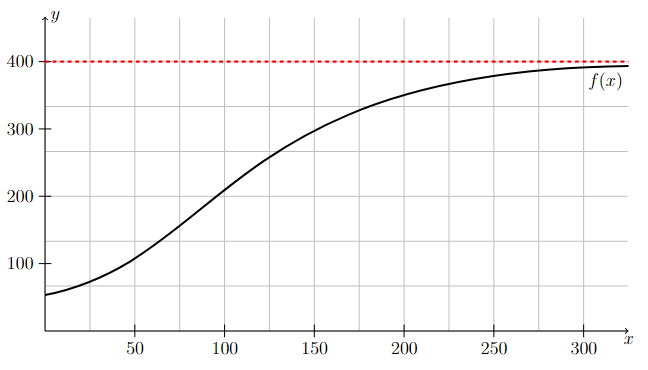Limits at Infinity#
Definitions#
Definition
The limit of \(f(x)\) as \(x\) approaches (positive) infinity is equal to the finite number \(L\), denoted by
if \(f(x)\) can be made as close to \(L\) as we want by taking \(x\) large enough.
Definition
The limit of \(f(x)\) as \(x\) approaches negative infinity is equal to the finite number \(M\), denoted by
if \(f(x)\) can be made as close to \(M\) as we want by taking \(x\) to be negative and sufficiently large in absolute value.
Example 1#
A limit at infinity
The following graph illustrates a function \(f(x)\) that approaches a value of 400 as \(x\) increases without bound. In other words,

Long Text Description
There is a horizontal x-axis with the points 50, 100, 150, 200, 250, and 300 marked. There is a vertical y-axis with the points 100, 200, 300, and 400. There is a horizontal red dotted line at y = 400. The graph of a function is plotted on these axes. The function is increasing and approaches the horizontal dotted line from below, but never reaches it. The closer the graph of the function gets to the horizontal dotted line, the slower the graph of the function increases.
Properties of Limits at Infinity#
Properties
All Properties of Finite Limits apply when \(a\) is replaced with \(\infty\) or \(-\infty\). Furthermore, the following additional properties are especially useful when evaluating limits at infinity. For all \(n>0\), we have
\(\lim\limits_{x \to \infty} \dfrac{1}{x^n}=0 \)
\(\lim\limits_{x \to -\infty} \dfrac{1}{x^n}=0\), provided that \(x^n\) is defined for \(x<0\).
Example 2#
Limits at infinity of \(1/x\)
Notice how the graph of \(y=1/x\) approaches the \(x\)-axis as \(x\) approaches positive and negative infinity. In other words,

Long Text Description
There is a horizontal x-axis with the points -5, -3, -1, 1, 3, and 5 marked. There is a vertical y-axis with the points -1 and 1 marked. The graph of the function y = 1/x is plotted on these axes. This function comes in just below the x-axis from the left, decreases to negative infinity as x approaches zero from the left. The function is not defined at x = 0. As x increases past zero, the function comes down from positive infinity and decreases towards the x-axis as it continues to the right.
Example 3#
Limits at infinity of \(1/\sqrt{x}\)
Notice how the graph of \(y=1/\sqrt{x}\) approaches the \(x\)-axis as \(x\) approaches positive infinity. In other words,
Furthermore, there is no discussion of the limit as \(x\) approaches negative infinity since \(\sqrt{x}\) is not defined for negative values of \(x\).

Long Text Description
There is a horizontal x-axis with the points -5, -3, -1, 1, 3, and 5 marked. There is a vertical y-axis with the points 1 and 2 marked. The graph of the function one over square root x is plotted on these axes. The graph does not appear above negative x values. The function is not defined at x = 0. As x increases past zero, the function comes down from positive infinity and decreases towards the x-axis as it continues to the right.
Limits at Infinity of Rational Functions#
How to Compute the Limit at Infinity of a Rational Function
For rational functions, the limit as \(x\) approaches positive or negative infinity can be determined by comparing the degree of the polynomial in the numerator to the degree of the polynomial in the denominator.
For the limit at infinity of a rational function, if the
highest power is in the denominator, then the limit exists and is equal to \(0\).
highest power is in the numerator, then the limit does not exist (DNE) and goes to positive or negative infinity, which can be determined by a careful examination of the leading terms.
highest power is the same in both the numerator and denominator, then the limit exists and is equal to the ratio of the leading coefficients (i.e., the ratio of the coefficients of the highest powers in the numerator and in the denominator).
Example 4#
Limits at infinity of rational functions
\(\displaystyle\lim_{x\to\infty}\frac{x+3}{6x^2+3x+1}\)
Answer
Since the highest power of \(x\) is in the denominator, the limit exists and is equal to \(0\).
\(\displaystyle\lim_{x\to-\infty}\frac{6x^{3}+3}{x^{2}+4x-7}\)
Answer
Since the highest power of \(x\) is in the numerator, the limit does not exist (DNE).
Furthermore, by comparing the leading terms in the numerator and the denominator, we can determine whether the limit goes to postive or negative infinity. Since the leading term in the numerator, \(6x^3\), is negative as \(x\) goes to negative infinity and the leading term in the denominator, \(x^2\), is postive as \(x\) goes to negative infinity, the ratio of the leading terms (negative/positive) is negative. Therefore, we can conclude that the limit goes to negative infinity (\(-\infty\)).
\(\displaystyle\lim_{x\to\infty}\frac{4x^5+3x-8}{9x^5-6x^3}\)
Answer
Since the highest power of \(x\) in the numerator and in the denominator are the same, the limit exists and is equal to the ratio of leading coefficients, which in this case is \(4/9\).
